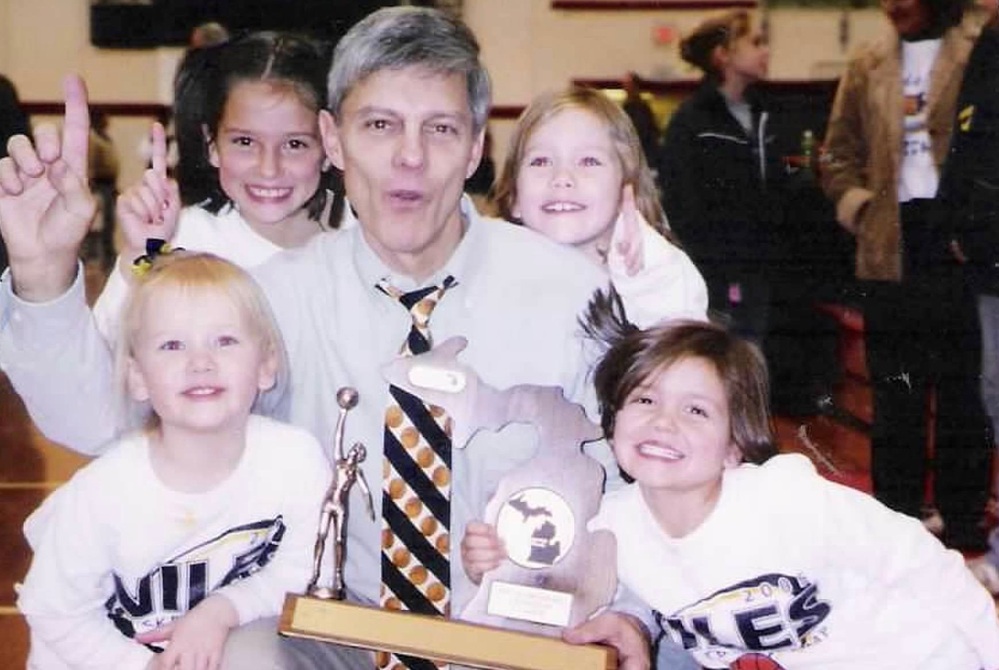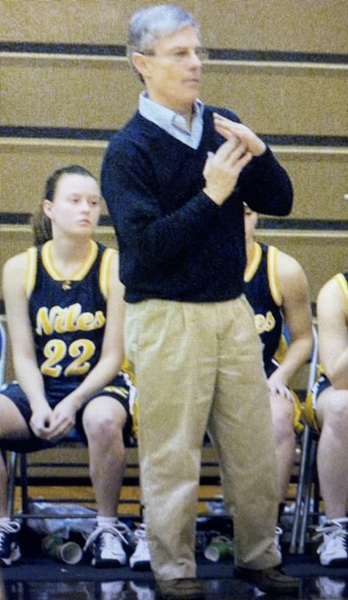
Keep on Coaching
February 1, 2013
By Geoff Kimmerly
Second Half editor
A few weeks ago, I finally got my first chance this season to watch a friend coach his basketball team. After guiding some others at the lower levels, this is his first time running the varsity – something he wasn't sure he wanted to do with a 1-year-old just learning to walk, but a challenge he ended up taking on to the benefit of all those involved.
Simply put, he’s good. I've seen a lot of teams and a lot of coaches over the past 15 years, and although I wouldn't know much of what to do if I were walking the sideline, I felt pretty qualified in telling him I was impressed – even if he didn't buy that I was offering an unbiased opinion. The best news is he’s gone from not sure about this a few months ago to talking about next season.
We know, at least anecdotally, that coaching continues to get more challenging. The time commitment has grown substantially to make running a program a year-round endeavor in a lot of sports at a lot of schools.
That commitment – especially for coaches with children of their own – was a main reason referred to in a New Haven Post-Chronicle story Saturday that noted 23 football coaching openings in Connecticut at one point this offseason. That state has 146 football teams – meaning roughly 15 percent will have new leaders this fall.
And that got me thinking about my friend, about how glad I am he’s given this a shot, and how I've seen so many others either not do so, or not stick around long despite having some pretty nice success.
A study published last winter in Interscholastic Athletic Administration magazine – a product of the National Interscholastic Athletic Administrators Association – noted some predictable results of a study that sought to determine the biggest challenges faced by first-year high school coaches.
The toughest according to the study was balancing the demands of coaching and teaching, experienced by nearly half the respondents – 98 percent of which coached high school teams and 81 percent of which are teachers.
The next six reasons all were noted by at least 30 percent of those in the study – personal fatigue, securing community support, securing and caring for facilities and equipment, parental contact, keeping non-starting players motivated, dealing with schedule interruptions and motivating athletes to achieve consistent, peak performance.
Nothing there is earth-shaking, and most if not all of these challenges are faced by high school coaches regardless of how long they've been in the field. But I got a little more perspective from some of the 32 items that ranked as least challenging to the first-year leaders – keeping in compliance with state and league regulations, dealing with substance abuse issues, teaching sport skills and creating a positive team atmosphere – things that seem most important, and yet appear to be easiest to do. I’m not sure what that tells us – but I think it tells us something.
Click to check out the entire three-page breakdown of the study, plus the researchers’ recommendations to remedy some of what first-year coaches face.
Giving back to Saginaw
I love reading about high-level athletes – like a star-studded group of alums from Saginaw – giving back to where they got their starts.
Pittsburgh Steelers star LaMarr Woodley made a big impact before the start of this school year by donating $60,000 to cover all participation fees for athletes in his former school district. The Saginaw News’ Hugh Bernreuter writes today about how Woodley (Saginaw High), the Philadelphia 76ers’ Jason Richardson (Saginaw Arthur Hill) and former Oakland Raiders standout Stu Schweigert (Saginaw Heritage) have combined to give more than $865,000 back to their home communities.
Bernreuter also mentions the non-monetary contributions of the Golden State Warriors’ Draymond Green (Saginaw High) and former Indianapolis Colts receiver Blair White (Saginaw Nouvel).
Click to read more about it.
Quote(s) of the Week
While rifling through more papers on my desk, I found an article from the Washington Post from Sept. 2011 titled “How high school sports save our schools.” I was drawn to it in part because I spent more than a decade in a newsroom, and it was a piece by a reporter covering education who instead of reporting on school boards and the like, delved into the importance of interscholastic athletics to education as a whole.
He spoke of how participation continues to grow even as resources dwindle, and of data supporting that extracurriculars like sports are more effective than academic classes in teaching leadership, teamwork, time management and “other skills crucial for success in the workplace.” Later, he mentioned a study noting that those who participate in extracurriculars earned more a decade later.
Click here to read the entre piece. These passages struck me most.
“Coaches might be the only faculty members still allowed by our culture and educational practice to get tough with students not making the proper effort. They have the advantage of teaching what are essentially elective non-credit courses. They can insist on standards of behavior that classroom teachers often cannot enforce because the stakes of dismissing or letting students drop their courses are too high. …
“Students do better in activities they choose. If we provide more of them, led by committed adults … that can make a difference. We know the bad news about education. Dropout rates are high. Achievement scores are stagnant. But sports participation is going up, despite pressure to cut it back. Let’s cheer about that and look for a way to draw in more students.”

Niles' Arnold Remembered as Teacher & Leader, 'Doing Exactly What He was Meant To Do'
By
Scott Hassinger
Special for MHSAA.com
January 13, 2026
NILES – Throughout his 22-year career coaching varsity girls basketball at Niles High School, Jim Arnold required one thing from his players.
 Just have fun.
Just have fun.
"Jim always stressed to his players that the one thing he wanted them to do when on the floor was to just have fun playing the game," said George Brawley, who served 15 seasons as one of Arnold's assistant coaches at various levels.
Arnold, 81, died Dec. 9 following an extended illness.
But throughout his career, Arnold's teams did much more than just enjoy themselves. The Benton Harbor native built a highly-successful program at Niles, where he achieved an overall win-loss record of 360-139 from 1986-2008, with 19 winning seasons. Under Arnold's watch, the Vikings captured seven conference titles, 10 District championships – including nine straight from 1997-2005 – and five Regional crowns.
Among Arnold's other accomplishments were being named Class B Coach of The Year by The Associated Press in 1998 and receiving honorable mention in 1997, along with selection by the Basketball Coaches Association of Michigan as Region 5 Coach of the Year in 2002 and 2004. He was also named conference Coach of the Year seven times and received the Herb Quade Memorial Sportsmanship Award for the 2002-2003 season.
Arnold also coached Niles to back-to-back District championships in softball in 1993 and 1994.
As young athlete himself, Arnold excelled on the baseball diamond. A successful player while at Benton Harbor, he also played on Twin City American Legion teams and was known as a team captain and a coach on the field. Arnold later had an invitation to try out at the professional level with the Baltimore Orioles, but an injury ended his pursuit of that dream.
Arnold later played third base for Bargain Center, a slow-pitch softball team that won a regional championship and went on to play in the national title game in St. Louis, Mo.
 His daughters Sonya and Allison were among the athletes that Arnold mentored during his coaching career. Sonya (Martinez), his oldest daughter, played for her father in eighth grade.
His daughters Sonya and Allison were among the athletes that Arnold mentored during his coaching career. Sonya (Martinez), his oldest daughter, played for her father in eighth grade.
"He made the game fun, and you wanted to do your best because you didn't want to disappoint him. He poured his heart into each and every practice and game because preparation mattered to him. He demanded excellence, and every player became better because of his coaching ability," said Martinez, a 1986 Niles graduate.
Allison (Clay) his youngest daughter, played on the 1990 Niles varsity squad that finished 25-1, winning conference, District and Regional titles. She is a 1991 graduate.
"It was awesome playing for my dad. Some of my best memories in my life were during that time,” Clay said. “He had high standards and inspired others to be the best version of themselves. He put his heart and soul into what he did, and I had a front-row seat to that."
Linda Arnold has fond memories as a coach's wife.
"I loved watching my husband coach because of the joy it brought him. His passion, intensity and the love he had for his players was genuine,” she said. “It was more than a game. It was more about developing players in the area of discipline, teamwork and giving your all. Even in the busiest part of the season, he always made me feel like a priority. I didn't just watch a coach. I watched a man doing exactly what he was meant to do.
"My husband coached with passion, but he loved his family with intention. My girls would go to his practices and we all attended his games, and we had the team over for team dinners. His players were a part of our extended family. He made sure we felt a part. He was the best coach in the world, and he was mine."
Jim Arnold was highly respected by his coaching peers. He was kind and treated everyone with dignity. The community of Niles knew what he stood for and they knew his standards were high. He was admired for his preparation and understanding of the game as well as his commitment to doing things the right way. He was strict but fair and treated everyone the same, whether you were the star player or last one off the bench, Martinez explained.
"Developing his players' character was far more important to him than winning," she said. "Dad lived what he taught. He modeled humility, hard work and lived a life of integrity. He made people better by being a part of their lives."
When Jim Arnold first began his junior high teaching career in Niles, he also coached the boys junior high basketball team. There were no girls basketball teams at the time, so a girl tried out for the boys team. She was good enough to make the team, so Arnold kept her. The following school year, the principal asked Arnold to organize a girls team – and the rest was history.
Former Niles varsity girls basketball coach Jessica Johnson, a teammate of Clay’s, recalls the experience of playing for Coach Arnold.
 "Coach Arnold taught us discipline, resilience and always required 110 percent effort from you. He would instill confidence in you while still holding you accountable," said Johnson, now an assistant women’s basketball coach at Southwestern Michigan College.
"Coach Arnold taught us discipline, resilience and always required 110 percent effort from you. He would instill confidence in you while still holding you accountable," said Johnson, now an assistant women’s basketball coach at Southwestern Michigan College.
Johnson recalls Arnold's use of comic strips as a teaching tool to help his players improve upon their mistakes.
"If you had a game where you didn't shoot very well or took questionable shots, he would place pictures of bricks in the gym the day following the game," Johnson said.
"Coach Arnold went out of his way to build that relationship and trust with his players. He gave us lessons that extended way beyond the court that made us better people."
Mark Haase, a Niles alumnus and the current Vikings head varsity boys basketball coach, also had the privilege of playing for Arnold.
"I played freshman basketball for Coach Arnold. It was one of the most disciplined and well-conditioned teams I ever played on. He ran a tight ship, but it was done out of love and concern for his players. He has a great family and is a Niles legend," Haase said.
Niles athletic director Matt Brawley referred to Arnold as an amazing teacher, coach and individual in the school and community.
"Coach Arnold would never ask you to do anything he wouldn't do. He was very structured and expected a lot out of his players, and he got results without excuses,” Brawley said. “He was a true leader of Niles athletics. He was an unbelievably kind and humble individual.”
 Scott Hassinger is a contributing sportswriter for Leader Publications and previously served as the sports editor for the Three Rivers Commercial-News from 1994-2022. He can be reached at [email protected] with story ideas for Berrien, Cass, St. Joseph and Branch counties.
Scott Hassinger is a contributing sportswriter for Leader Publications and previously served as the sports editor for the Three Rivers Commercial-News from 1994-2022. He can be reached at [email protected] with story ideas for Berrien, Cass, St. Joseph and Branch counties.
PHOTOS (Top) Jim Arnold poses for a photo with his granddaughters following a Niles girls basketball game. (Middle) Arnold signals for a timeout. (Below) Linda and Jim Arnold, seated (middle) take a photo with their daughters and their families. (Photos courtesy of the Niles athletic department and Arnold family.)

